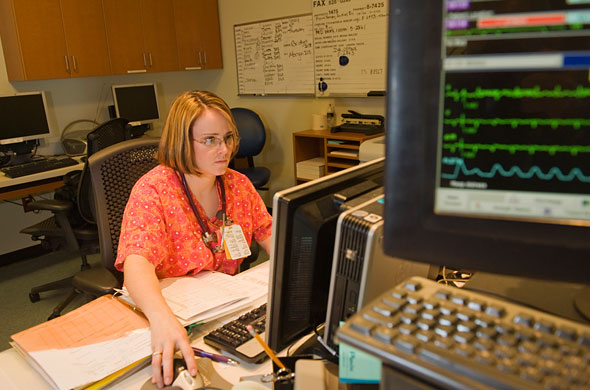
Care at the click of a button
Remember paper? Since the VCU Health System implemented Cerner, its housewide electronic medical record system, in 2004, patients, practitioners, residents and staff have been forced to ask that question with more frequency, as the information technology platform has grown to encompass nearly every facet of patient care — from placing orders and retrieving lab results, to triaging ER patients, updating notes and writing prescriptions, all electronically.
For Colin Banas, M.D., chief medical officer at the VCU Medical Center’s Office of Clinical Transformation and associate professor in the Department of Internal Medicine, Cerner is, quite simply, “the game changer.”
Though he was named one of the top 25 clinical informaticists in the country in the November 2011 issue of Modern Healthcare magazine, Banas’ first introduction to Cerner came when he was forced to use the new software as an internal medicine resident at VCU, and he admitted to being apprehensive about the switch. But, he said, he quickly realized that the growing pains associated with leaving paper behind were well worth it, and now he considers Cerner to be “the single biggest thing we’ve done for patient care in the past 10 years.”
“It sets the foundation for true collaboration,” he added, “that ultimate vision where the appropriate information is seamlessly transferred to the right people at the right time.”
VCU’s commitment to Cerner during the past seven years has allowed the technology to grow from a basic record-keeping tool to a comprehensive, integrated system that can continue to evolve and streamline care.
For example, the medical center has seen its incidence of deep venous thrombosis (a common condition involving the formation of blood clots in the legs of stationary patients) decrease over the past decade thanks to measures in Cerner that help ensure that the appropriate prophylaxis to prevent thrombosis is part of a patient’s standard electronic order set. Should an oversight occur and that order isn’t made, Cerner will alert the physician. The system similarly warns physicians of potential allergic reactions and whether certain prescribed medicines have been properly dosed according to factors like a patient’s weight or kidney function.
The evolution of features such as interactive dashboards also allow physicians working in teams to monitor their patients’ progress, assess potential risk factors in the course of treatment, update care plans, targets and goals and communicate with other providers.
“Ten years ago, it was nice to be able to see the labs and place orders electronically,” Banas said. “But now we have a system that proactively tries to guide you down the right path.”
So, gone is the stereotypical image of the pen-clicking doctor, flipping open thick manila folders stuffed with potentially illegible notes or out-of-date information that can lead to untold errors. In its place stands the physician with his laptop (or even his phone as the technology develops), able to call up a patient’s electronic medical history and course of treatment from his office, his home and even on the road, as well as from the bedside.

